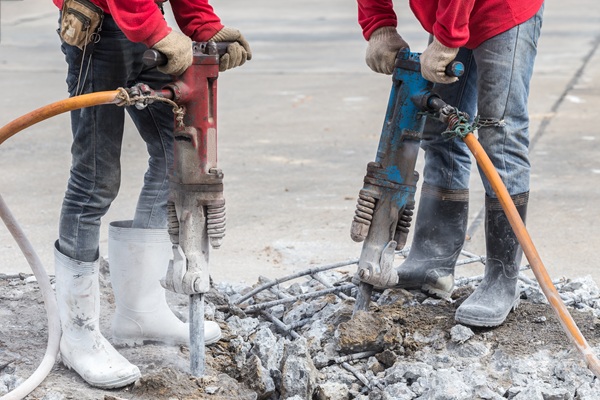
Too many workers treat hand pain as “just part of the job.”
Workers in many trades use the side of the palm to push, pound, or twist objects when a tool isn’t handy. It might seem harmless, but over time, this practice can lead to a painful and sometimes disabling condition called hypothenar hammer syndrome. This occurs when the ulnar artery in the palm is damaged, resulting in the interruption of normal blood flow to the fingers.
The ulnar artery runs along the side of the palm, near the fleshy area opposite the thumb. Every time you strike, grind, or press with that part of your hand, you risk injuring the artery. Repeated trauma can weaken the vessel wall, cause narrowing, or even lead to blood clots that reduce circulation to your fingers.
Sometimes a single hard impact is enough to trigger the condition, but more often it develops gradually from years of repetitive stress. Workers who use vibrating tools are at even higher risk because the constant shaking puts added strain on the artery. Reduced blood flow means the fingers aren’t getting enough oxygen, and that’s when symptoms start.
If you suffered from this condition on the job in San Diego, here's how a lawyer can help you pursue workers' comp benefits.
Who is most at risk for hypothenar hammer syndrome?
Certain jobs make workers more vulnerable because of the repetitive tasks involved. Auto mechanics, machinists, and metal workers often put heavy pressure on their palms while tightening or grinding. Miners, carpenters, and bricklayers are constantly exposed to the pounding and vibration of tools. Butchers and bakers use repetitive hand motions that can create similar stress.
Anyone who regularly handles vibrating tools, such as jackhammers, chainsaws, or grinders, should also exercise caution.
What are the symptoms of hypothenar hammer syndrome?
Early signs of hypothenar hammer syndrome may be easy to dismiss, but they shouldn't be ignored. Common symptoms include pain or tenderness on the edge of the palm, tingling or numbness in the fingers, and occasional numbness in the hands.
As the condition worsens, workers may find it difficult to grip heavy objects, and their fingers may turn pale or bluish. Many notice their hands become unusually sensitive to cold. In advanced cases, circulation problems can cause permanent nerve or tissue damage.
How is the condition diagnosed and treated?
Doctors start with a detailed medical history, focusing on work habits and hand use. They will examine the hand to check blood flow and may order imaging tests, such as an ultrasound or angiography, to assess the state of the artery.
In some cases, specialized vascular testing is done to measure how the fingers react to changes in blood flow or cold exposure. Because hypothenar hammer syndrome shares symptoms with other hand conditions like carpal tunnel or arthritis, proper diagnosis is key to getting the right treatment.
The approach depends on the severity of the damage. For many workers, resting the hand and avoiding further trauma is the first step. Doctors may prescribe medication to improve circulation or dissolve clots. Wearing padded gloves or splints can also help relieve stress on the artery.
In more serious cases, surgery may be needed to repair or bypass the damaged section of the artery. If an aneurysm has developed, surgeons may remove it to restore blood flow.
How can you avoid hypothenar hammer syndrome?
Prevention begins with simple changes in your work habits. Avoid using the palm as a hammer, and rely on the proper tool for the job instead. If your work involves frequent hand impact, invest in padded or anti-vibration gloves.
Employers can help by rotating tasks so workers aren’t exposed to the same repetitive motions all day. Safety training that highlights the risks of hand trauma is also an important step. Awareness is key; once workers are aware of the danger, they can take steps to protect themselves.
When should I see a doctor for hypothenar hammer syndrome?
If you notice persistent pain, tingling, or numbness in your palm or fingers, don’t wait for it to get worse. Fingers that change color or become unusually sensitive to cold are also warning signs. The earlier you get a diagnosis for hypothenar hammer syndrome, the better the chances of preventing permanent damage.
Many workers mistakenly believe this condition is minor or assume it’s just part of the job. But hypothenar hammer syndrome is a real occupational hazard, and untreated cases can lead to long-term disability.
Healthy hands are needed for anyone working in skilled trades, and protecting them should be a priority.
Can I file a workers' compensation claim if I suffered hypothenar hammer syndrome?
If you’ve been diagnosed with hypothenar hammer syndrome as a result of your work, you know how painful and limiting this injury can be. Losing the strength and dexterity in your hands doesn’t just affect your job; it affects every part of your life.
Robert A. McLaughlin understands the seriousness of this condition and the frustration it can cause when the workers’ compensation system makes it harder, rather than easier, to obtain the medical treatment and wage benefits you need. Our team stands up to insurance companies and makes sure your rights are fully protected.
From the shipyards in San Diego’s South Bay to the construction sites of East County, and from the restaurants in Mission Beach to the hospitals in Hillcrest, we’ve fought for injured workers across San Diego County and throughout California.
We know the system, we know the tactics employers and insurance companies use to reduce your benefits, and we know how to build a case that puts your health and your future first.
Whether your injury came from years of tool vibration, heavy equipment use, or repetitive palm impact, we’ll take the time to understand your story and fight for the benefits you deserve. Contact us today to schedule your free consultation.
